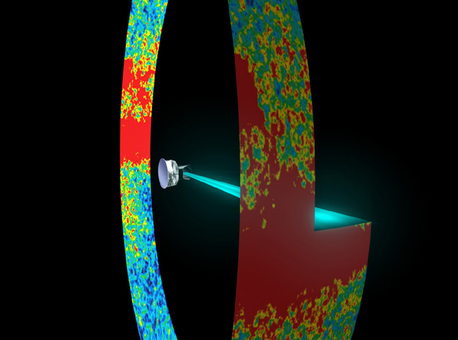Astronomy's Dark Side
What is dark energy?
 © ESA/C. Carreau |
The Planck spacecraft, which was launched on 14 May 2009, scans the entire sky in the microwave range. Characteristics of dark energy will be derived from its observations.
In 1998, this abruptly changed. Two research groups used exploding stars – type 1a supernovae – to show that the cosmic expansion is not being slowed down as expected by gravitational attraction between the matter in the Universe. In fact, the Universe is expanding increasingly quickly. However, an accelerating expansion in a Universe with a cosmological constant is to be expected. The cosmological constant might correspond to a special form of energy that counteracts the mutual attraction of matter. The term 'dark energy' has established itself as a generic name for the various attempts made by astronomers to explain the observations. The existence of dark energy has been confirmed and quantified as a result of various studies – for example, on microwave background radiation, the large-scale distribution of matter in space and using gravitational lenses. Around 70 percent of the Universe (and its density of electromagnetic energy) consists of dark energy!
However, astronomers are still speculating as to the nature of dark energy. It is often interpreted as being a characteristic of a vacuum –'vacuum energy'. In what are known as quintessence models, dark energy is a time-dependent variable. Perhaps it is a natural constant that depicts a curvature of space that is unrelated to the presence of matter? Some theories avoid the concept of dark energy and attempt to explain the observations by an inhomogeneous distribution of matter throughout the Universe. Numerous experiments are currently being planned in order to test these and other ideas.
German Aerospace Center
Astronomy's Dark Side
What is dark energy?
 © ESA/C. Carreau |
The Planck spacecraft, which was launched on 14 May 2009, scans the entire sky in the microwave range. Characteristics of dark energy will be derived from its observations.
In 1998, this abruptly changed. Two research groups used exploding stars – type 1a supernovae – to show that the cosmic expansion is not being slowed down as expected by gravitational attraction between the matter in the Universe. In fact, the Universe is expanding increasingly quickly. However, an accelerating expansion in a Universe with a cosmological constant is to be expected. The cosmological constant might correspond to a special form of energy that counteracts the mutual attraction of matter. The term 'dark energy' has established itself as a generic name for the various attempts made by astronomers to explain the observations. The existence of dark energy has been confirmed and quantified as a result of various studies – for example, on microwave background radiation, the large-scale distribution of matter in space and using gravitational lenses. Around 70 percent of the Universe (and its density of electromagnetic energy) consists of dark energy!
However, astronomers are still speculating as to the nature of dark energy. It is often interpreted as being a characteristic of a vacuum –'vacuum energy'. In what are known as quintessence models, dark energy is a time-dependent variable. Perhaps it is a natural constant that depicts a curvature of space that is unrelated to the presence of matter? Some theories avoid the concept of dark energy and attempt to explain the observations by an inhomogeneous distribution of matter throughout the Universe. Numerous experiments are currently being planned in order to test these and other ideas.
German Aerospace Center





